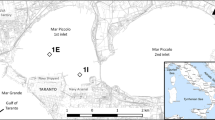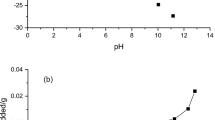Abstract
The transfer of metals from contaminated sediments to algal cell walls (Scenedesmus quadricauda) and organisms from various trophic levels (euryhaline osmoconform hydroid Cordylophora caspia and algae Brachiomonas submarina) was studied with a multichamber device. The system consists of a central chamber which contained the mud suspension and six external chambers containing the different biological indicators. The solids in the central and external chambers are separated by 0.45 μm-diameter membranes which allow diffusion of the mobilized, dissolved metal compounds. Experiments were performed with dredged sediments at various salinities (0.5, 1.0, 1.5, and 2.0 percent, respectively) and the kinetic of re-adsorption was obtained by taking samples after different time intervals. High enrichment of Cd was found in the living alga Brachiomonas submarina, but on the other side only a weak influence of salinity on re-adsorption could be observed. Model experiments with ionic Cd showed a clear dependency on Cd-sorption on the algae, Cd-concentration in solution, and salinity. These results indicate that the transfer of metals mainly depends on the specific surface properties of the substrates and on the specific chemical form of the dissolved mobilized metal.
Similar content being viewed by others
References
Ahlf, W., 1988. Transfer of heavy metals from suspended sediments to the alga Stichococucus bacillaris in an estuarine water medium. Wat. Sci. Tech. 20: 33–38.
Benjamin, M. M. & J. O. Leckie, 1981. Multiple site adsorption of Cd, Cu, Zn, and Pb on amorphous iron oxyhydroxide. J. Colloid Interfac. Sci. 79: 209–221.
Calmano, W., W. Ahlf & U. Förstner, 1988a. Study of metal sorption/desorption processes on competing sediment phases with a multichamber device. Envir. Geol. Wat. Sci. 11: 77–84.
Calmano, W., W. Ahlf, H. Baade & U. Förstner, 1988b. Transfer of heavy metals from polluted sediments under changing environmental conditions. In: M. Astruc & J. N. Lester (eds), Heavy Metals in the Hydrological Cycle. Selper Ltd., London: 501–506.
Förstner, U., W. Ahlf, W. Calmano & C. Sellhorn, 1984. Schwermetall/Feststof Wechselwirkungen in Ästuargewässern: Sorptionsexperimente mit organischen Partikeln. Vom Wasser 63: 141–156.
Förstner, U., W. Ahlf & W. Calmano, 1989. Studies on the transfer of heavy metals between sedimentary phases with a multichamber device: Combined effects of salinity and redox variation. Mar. Chem. 28: 145–158.
Gamble, D. A., A. W. Underwood & C. H. Langford, 1980. Copper(II) titration of fulvic acid ligand sites with theoretical potentiometric and spectrophotometric analysis. Analyt. Chem. 52: 1901–1908.
Leckie, J. O., 1986. Adsorption and transformation of trace element species at sediment/water interfaces. In: M. Bernhard, F. E. Brinckman & P. J. Sadler (eds), The Importance of Chemical Speciation in Environmental Processes. Springer-Verlag Berlin, London, New York: 237–254.
Author information
Authors and Affiliations
Rights and permissions
About this article
Cite this article
Calmano, W., Ahlf, W. & Bening, J.C. Chemical mobility and bioavailabity of sediment-bound heavy metals influenced by salinity. Hydrobiologia 235, 605–610 (1992). https://doi.org/10.1007/BF00026248
Issue Date:
DOI: https://doi.org/10.1007/BF00026248




